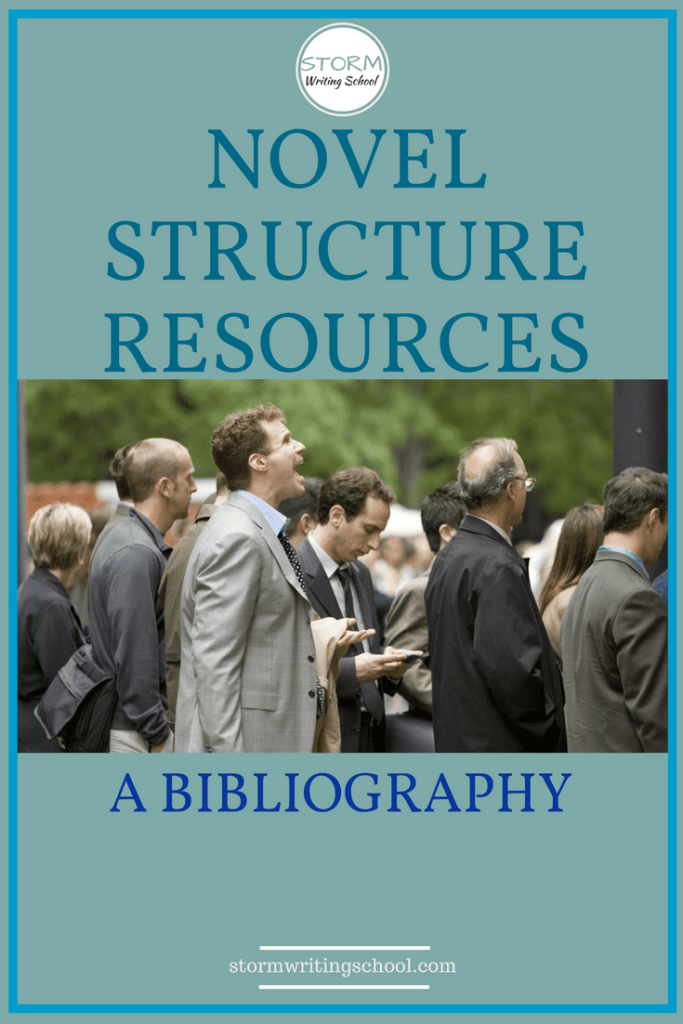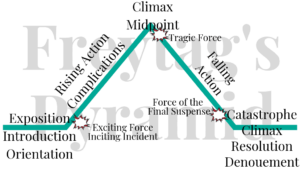In preparation for a class I’m teaching this weekend, I’ve done an exhaustive exploration of novel and story structure advice. Below, I’ve assembled what is more or less a bibliography. Consider this a list of resources more than the typical craft tip article. Bookmark this one and come back to it for future reads. (For my next article, I hope to compile some thoughts about the common elements among all of these structure paradigms.)
I have first and foremost Eva Deverell to thank for this. She has a superb article on plot formulas on her site, wherein she defines plot formulas as “any simplified story framework that helps you create your own story.” I’ve always been a bit wary of plot formulas, but I can get behind Deverell’s definition. In her article, she discusses over 15 plot paradigms, and she has a downloadable “plot formula cheat sheet,” which summarizes several of them. Her article and her cheatsheet were launching pads for my own research. (And in fact, I assembled a cheat sheet which includes some of Deverell’s summaries and adds several more.)
Now, my objective here is not to promote formulas at all but just to provide a survey of what’s out there. It’s an intimidating world, but a novel is an ambitious undertaking, and even if you’re going to approach it by discovering the story as you write, it’s still worth getting familiar with story structure because eventually, you’re going to need it. After looking into all of these structures, I’ve come away with a pretty good idea of the imperatives. But that’s an article for a different day.
Acts
Before I delve into the structures, a word about acts. C.S. Lakin has a great article about the arbitrary nature of acts. Act divisions are often for purposes other than story optimization. Sometimes, they just serve to give the audience a chance to use the bathroom; sometimes, they’re for commercial breaks (if you’re writing for TV like Lakin’s mother did). I would add that you can retroactively fit almost any act structure on any story. James N. Frey, in his book How to Write a Damn Good Thriller, promotes a five-act structure. But the first two movies he uses to exemplify his structure are Fargo and Alien, which I rewatched, and both of them can very easily be broken into 3 or 4 acts.
In short, I don’t know how useful acts really are, but as we all know, stories have a beginning, a middle, and an ending, and the three-act paradigm arises out of that very simple and logical fact. There’s no doubt that the three-act framework is the most popular among structure gurus. You can, however, overlay a five-act framework on top of it, as Shawn Coyne does in his book The Story Grid. Coyne talks about a three-act structure, but also “five commandments,” which include inciting incident, progressive complications, crisis, climax, and resolution. One could argue that every paradigm includes both three acts (beginning hook, middle build, ending payoff, as Coyne calls them) and the five commandments (which align more or less with Frey’s five-act structure). The inciting incident occurs in the beginning hook; the middle build is all about the progressive complications; and the ending payoff comes from crisis, climax, and resolution.
The Structural Frameworks
But without further ado, let me get into the list of structure paradigms. I break them down into three categories:
- Named stages. These are the kinds that list various parts of a long-form story labeled with more helpful names than “first plot point.” You see labels like “Stasis” and “Trigger” and “Shift” or “Crossing the Threshold” and “the All Is Lost Moment.”
- Plot point outlines. These list things like plot points, pinch points, turning points, etc.
- Process guides. These investigate universalities among stories but don’t necessarily promote a specific sequential structure.
Named Stages
One of the most popular named-stages structures is the hero’s journey, first identified by Joseph Campbell and then made into a writing tool by Christopher Vogler, who wrote a book called The Writer’s Journey. Vogler discusses an inner journey and the outer journey. There are lots of beat sheets and scrivener templates for the hero’s journey, by the way. Here’s one: Ksenia Anske’s Scrivener template.
Eva Deverell has created an 8-stage story structure called the “One-Page Novel.” She supplies a spreadsheet and a scrivener template based on her structure. She’s a proponent of distinguishing story order from plotting order. That is, your story will obviously occur in order (1,2,3,4,5,6,7,8). But you should plot the end (8) first and then the beginning (1) and then the middle shift (5), etc. Her plotting order is 8,1,5,2,3,7,4,6. See her site or my cheat sheet below for her named stages.
Shawn Coyne of Story Grid says that Elizabeth Kubler-Ross’s 8 stages of coping with death are a great outline for a novel. He posits the Kubler-Ross Change Curve for Story, which names 8 stages of a story, mirroring the stages of grief, but he doesn’t push it too hard.
Nigel Watts has an 8-stage structure in his book Writing a Novel and Getting Published. Deverell’s One Page Novel is clearly influenced by Watts’ formula.
Blake Snyder’s book Save the Cat is a fun read targeting screenwriters. He has a 15-part structure that breaks into three acts. It’s very prescriptive (there are exact page numbers for the various “beats” of the story, based on a 120-page screenplay), but there are definitely some concepts worth looking at. And there are lots of beat sheets out there (here’s Jami Gold’s).
(By the way, a lot of the structure gurus are in the screenwriting world. People who make movies need to plan them out in advance because filming a scene costs a lot of money. So you don’t want to just feel your way in the dark when creating a feature-length narrative film. Blake Snyder, John Truby, Robert McKee, Michael Hauge, and Syd Field are all coming from a screenwriting camp. That’s not to say novelists should disregard them, though. They have some wonderful advice for structure. Look elsewhere for advice about narration or rendering in prose.)
Plot Points
For years, I was very turned off by this formulation because plot point and pinch point make no inherent sense. Once I discovered what each point means, however, I warmed to it. The first plot point, for instance, is basically the hero’s journey “crossing the threshold” moment.
K.M. Weiland’s formulation and explanation of the plot point structure is probably the best explained and most useful. Plus, she has some great resources, including a book, Structuring Your Novel, and a scrivener template. This is where I’d start for anyone wanting some clarity on plot points.
But Dan Wells makes for another good starting point to plot points. He is a charming SF nerd whose videotaped lectures on story structure lay out a 7-point system. He claims he got his structure from the Star Trek Role-Playing Game’s Narrator’s Guide: Hook, Plot Turn 1, Pinch 1, Midpoint, Pinch 2, Plot Turn 2, Resolution.
Syd Field is an old screenwriting guru, who wrote a book called Screenplay: The Foundations of Screenwriting, which came out in 1979. He’s one of the first to posit plot points. His structure seems to be the basic foundation for all the plot-point structures that follow, but I wouldn’t necessarily recommend it for novelists.
Larry Brooks promotes something similar to Dan Wells in his Story Engineering. Jami Gold has a better worksheet for Brooks’ structure than Brooks does. But Brooks has an exhaustive plot breakdown of Hunger Games that’s worth looking at.
Mixes
Some of the paradigms mix plot point terminology with stage names.
Take Alan Watt, for instance, author of The 90-Day Novel. His first act: Act One Opening, Dilemma, Inciting Incident, Opposing Argument, End of Act One. He’s mostly a named-stages kind of guy, but some of those names rely on the same act terminology as the plot point folks.
Same goes for C.S. Lakin, who has developed a structure that works for her, which may ultimately be what we all need to do. (Though I would also add that different books may require different structures.) Lakin has a unique 10-20-30 approach, wherein she plans the 10 main-plot scenes according to her structure. Then she writes those scenes. Next, she plans the principal subplot scenes (10 of them; same structure) and writes those. Her next 10 are the scenes that fill main plot gaps from 1 to 2, 2 to 3, etc. Her site has a lot of articles, which actually makes it somewhat hard to navigate, but here’s a decent starting point.
Lakin’s main inspiration for story structure is Michael Hauge, who is another one of the screenwriting gurus. Hauge promotes a six-stage structure with 5 turning points. He also has internal and external dimensions to his outline. Here is it in action with the films Erin Brockovich and Gladiator. Jami Gold has a spreadsheet for Hauge’s outline.
Process
Finally, there are what I call the process guides.
You may have come across John Truby’s 22-Step Structure somewhere. If you haven’t read his book, The Anatomy of Story, his structure makes absolutely no sense. But if you have read his book, it’s an incredibly useful tool. It’s not really an outline, though. One of his steps, for instance, is called Drive. Here’s Truby on the matter: “The drive is the series of actions the hero performs to defeat the opponent and win. Comprising what is usually the biggest section of the plot, these actions begin with the hero’s plan (Step 10) and continue all the way to his apparent defeat (Step 14).” So it’s not quite a sequential list so much as it is a collection of parts.
Lisa Cron’s book Story Genius is even less structure oriented, but it’s another great resource. She not only supplies some very insightful and convincing arguments about what a story is and what it needs in order to resonate with readers, but she also walks you through story creation using an exemplar writer in the process of creating a story.
Randy Ingermanson’s The Snowflake Method is a pretty famous process guide. Here’s a nice Scrivener Template for it. And here’s another one, available in several formats, not just Scrivener. Ingermanson’s website gives a pretty exhaustive explanation for the method.
Robert McKee’s Story is another great resource. McKee’s book is foundational story theory. He doesn’t give a lot of practical tips for employing his theories, but he’s got some sound theories nonetheless. I’d almost call this required reading for storytellers.
Shawn Coyne’s The Story Grid, which I’ve already referenced a few times, has some great advice. It may be especially useful for writers who are editing their work (an initial draft already done). The entire book is on his site for free in some form, by the way.
The Gary Provost Paragraph is definitely worth checking out. It’s more of a template for a synopsis of your novel and it pairs well with Truby and the Snowflake Method (elaborated upon in this article from Peter Rubie, who worked with Gary Provost when he was alive).
James Scott Bell’s book Plot and Structure isn’t strict about its outline but promotes a minimal “disturbance and two doors paradigm,” which I like (see the cheat sheet). I think there’s a strong argument to be made that even “pantsers,” or what Bell calls “discovery writers,” should at least figure out a few things in advance: the ending and then the disturbance and two doors.
And finally, I’d like to mention Dramatica. I referenced them in my previous post on why the hero’s journey may be wrong for your story. They have an article that examines five story structures plus their own. Once they get to talking about their own, they lose me. But, as I said in my last article, they have some ideas worth examining, and their theories need some serious unpacking (which doesn’t necessarily make them wrong). Dramatica is aware that not all stories are tales of positive transformation, and they have some good alternate views of story. They’re proponents of a four-act structure, which, given the prominence of the midpoint in pretty much every story structure I looked at, makes a lot of sense (Act 2 is always clearly split in 2 parts, so why not just call it two acts?).
Okay, then. Here’s what I’ve done with the above: I created a video that explains an aggregate novel structure, taking into account the common threads among many of the above paradigms. Be sure to take a look at that. And subscribe to the newsletter to be alerted about other great articles and course.

SaveSave
SaveSave
SaveSave
SaveSave
SaveSave
SaveSave
SaveSaveSaveSave
SaveSave








10 Responses
Fantastic article. Bookmarking!
Thanks, Raimey!
I’ve been beating myself up trying to push and prod my work using Truby’s book. I have sat through most of his videos and have copious notes. But I couldn’t get the nuts and bolts of the structure. Thanks for your comment. Dee
Yeah, Truby’s not all that clear with structure. If you want to wrap your head around structure, John Yorke’s Into the Woods is the best resource out there.